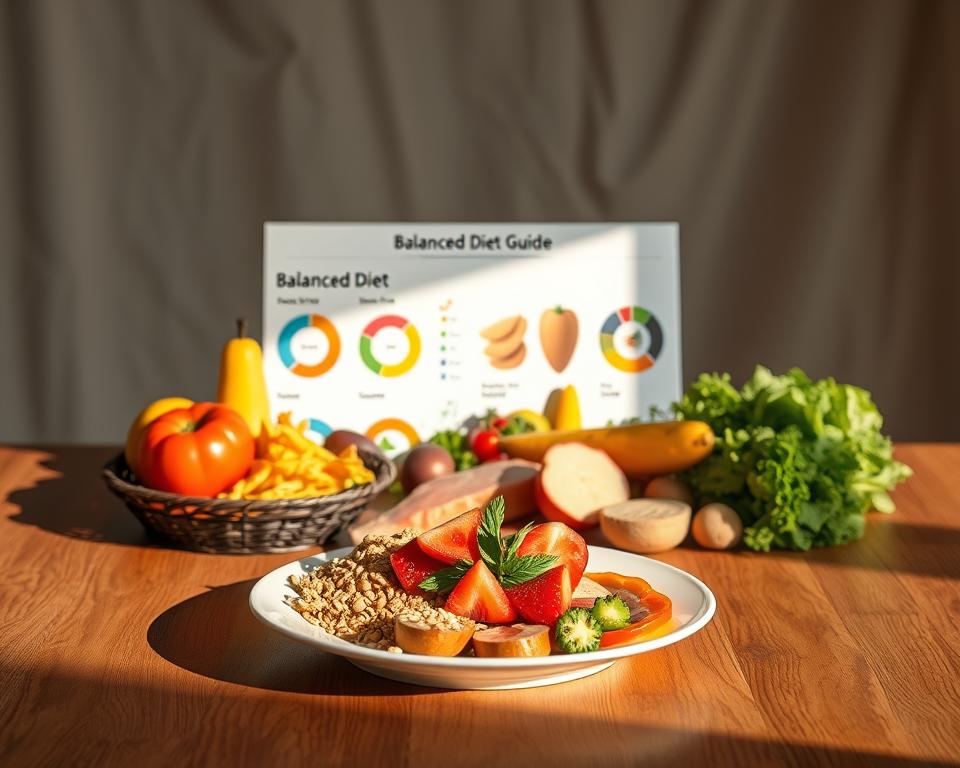Anúncios
Nutrition 2025 asks a simple question: could a few small, doable changes make your daily routine support your health instead of complicating it?
You will see how tiny slipups—skipping breakfast or sipping sugary drinks—add up in a busy life. This guide turns current science into practical steps, like meal planning, smart snacks, and label know‑how, so you can try fixes that fit your budget and schedule.
We highlight what research shows and what still needs more study, and we note major conferences that shape the field as new findings reach daily tips. Expect clear, friendly suggestions—not medical advice—and reminders to consult registered dietitians or your clinician for personalized guidance.
Start this week with a simple swap or a short plan, and use trusted sources to stay informed. Reliable information helps you make choices that benefit your life now and in the near future.
Introduction: common pitfalls in Nutrition 2025 and how to course-correct
Small, routine food choices often pile up and shape your day more than one big meal does. Skipping breakfast, grazing on ultra‑processed snacks, or misreading portions can lead to rebound hunger and energy dips.
Anúncios
Practical course‑corrections are simple and realistic. Plan regular meals, add fiber and protein to snacks, and set a water reminder. Use plate cues or labels to right‑size portions without strict rules.
- Pack a protein+produce snack for busy days.
- Scan labels for sodium and added sugars per serving.
- Set a phone alert to sip water at meals.
Current science favors steady pattern changes—think balanced, plant‑forward meals—over dramatic quick fixes. For trusted U.S. resources, check plain‑language materials from USDA, NIH, CDC, and FDA for label help and public health guidance.
Remember: this information is educational. If you have medical needs or allergies, consult a registered dietitian nutritionist or your healthcare team for tailored advice.
Anúncios
Everyday nutrition mistakes you can fix today
You can correct common slipups with a few practical moves that fit your budget and schedule. Below are quick, step-by-step fixes you can try this week. These tips are educational and not medical advice; consult a professional for personalized guidance.
- Skip rebound hunger: map three meals and 1–2 snacks on your calendar. At each meal add a protein (eggs, beans, yogurt), a high-fiber carb (oats, brown rice), produce, and a little fat to stay full longer.
- Replace ultra-processed snacks: make a grab-and-go list: apple + peanut butter, cottage cheese with berries, roasted chickpeas, or whole-grain crackers with hummus.
- Right-size portions: use your plate—half produce, one-quarter protein, one-quarter whole grains. Check labels for serving size vs. what you actually eat and watch added sugars and sodium.
- Hydration habits: drink water with meals and snacks, carry a bottle, flavor with citrus or mint, and swap one sugary drink per day for water or unsweetened tea.
- Avoid miracle claims: favor steady, balanced patterns. Try a new approach for two weeks, note how you feel, and adjust slowly.
- Spread protein: add protein to breakfast, lunch, dinner, and snacks (Greek yogurt, tuna, tofu, lentils) to balance intake across the day.
- Mind micronutrients: rotate iron (beans, beef), calcium (dairy, fortified milks), vitamin D (fatty fish, fortified foods), and potassium (bananas, potatoes).
- Shop smart: buy staples—dry beans, oats, brown rice, eggs, and frozen produce—and batch-cook two recipes to stretch meals.
- Honor culture and family: tweak favorites—add vegetables, choose whole-grain versions, or use gentler cooking—to keep changes sustainable.
- Quick label checks: compare sodium and added sugars per serving and prefer shorter ingredient lists when possible.
Small wins add up: rotate seasonal produce, try a new spice weekly, and aim for the better choice most of the time. For a deeper read on common pitfalls, see this guide to the top nutritional pitfalls.
What’s new in Nutrition 2025: science, conferences, and practical takeaways
Conference updates and new study formats are giving faster routes from lab reports to practical advice you can try at home. Major meetings now publish summaries, press briefings, and app schedules so you can follow topics without traveling.

American Society for Nutrition’s NUTRITION 2025 (Orlando): why encore abstracts matter for you
The american society nutrition annual meeting in Orlando added Encore Abstracts, letting prior posters reappear as posters on May 31–June 2. That increases visibility of repeat findings and makes post-conference writeups more likely.
Practical tip: scan the online schedule or mobile app for topics you care about. Look for university press releases or webinar recaps after sessions rather than relying on a single headline.
International Congress in Paris: “Sustainable Food for Global Health” in practice
The international congress nutrition in Paris centers on sustainability and affordability. E-posters, recordings, and networking areas let global teams share clinical, epidemiologic, and food science work.
Practical tip: use on-site e-poster libraries or public recordings to spot consistent themes across studies—those themes are more useful than one striking result.
From research to plate: applying new findings without overpromising
New research often needs replication. Favor consistent signals across multiple abstracts and sessions before changing habits.
Try small tests at home, like adding a bean-based lunch twice weekly, and track how you feel. That keeps expectations realistic while you benefit from evidence.
Connecting with professionals and public health guidance
Follow summaries from trusted groups and connect with a registered dietitian or local public health office for tailored advice. If you plan to attend or follow sessions, note that submission and registration windows open early—check meeting pages for updates.
Affordability, policy, and resilient habits in 2025
Rising grocery costs are changing what many households can afford and pushing smart, low‑waste habits into the spotlight. Global monitoring reports note that slowed progress on food security links closely to price inflation and uneven regional impacts.
The State of Food Security and Nutrition reports, edited by FAO, IFAD, UNICEF, WFP, and WHO, shows how inflation affects different food groups and the affordability of healthy diets. The analysis calls for sustained investment, clearer policy coordination, and more transparent platforms to build resilience.
Budget‑smart strategies
Plan a weekly menu and batch‑cook two anchor recipes—lentil chili or a whole‑grain pilaf—that you can repurpose into bowls, wraps, or soups.
Make pulses your pantry MVP. Pair dry beans, lentils, or chickpeas with brown rice, oats, or whole‑wheat pasta and frozen vegetables for balanced, low‑cost meals.
Community supports and policy actions
In the U.S., tap SNAP (look for Double Up Food Bucks in some states), WIC, school meals, and local food banks to stretch your grocery dollars.
Check your library or cooperative extension for free cooking classes and shopping tours. These platforms often offer practical tips that cut waste and save money.
- Compare unit prices and nutrition per serving; store brands can be a better value.
- Use the freezer to buy ripe, affordable frozen produce and rotate staples to keep variety low‑cost.
- When prices spike, keep a beans‑grain‑vegetable meal pattern and swap in the most affordable items that week.
Remember: policy change and industry shifts take time. Combining community resources, steady home habits, and advice from a registered dietitian for clinical nutrition needs can help you stay resilient while broader systems improve.
Conclusion
Conclusion
Turn evidence into action: try one easy swap each week—plan a simple meal, add a protein snack, or read one label—and note what helps you stay steady and satisfied.
Use conference summaries and abstracts from society nutrition meetings or an international congress nutrition to spot repeating themes in food science and nutrition science. When new findings arrive, check for consistency across sessions and watch submission timelines if you follow or present research.
For personal questions, connect with professionals or a registered dietitian for everyday tips or clinical nutrition needs. Small, steady steps that fit your budget and culture are the part that lasts.



